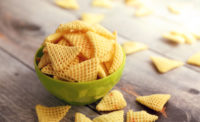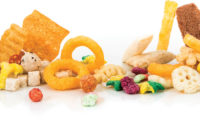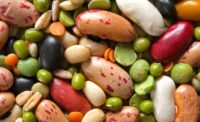With better-for-you trends dominating virtually every food and beverage category, how do puffed and extruded snacks fare? As it turns out, this category is in a unique position to capitalize. “The puffed and extruded snack market is growing,” says Dave Reynolds, area sales manager, Buhler Aeroglide, Cary, NC. “Snacks are not only becoming healthier, but more wholesome, satisfying, hearty and nutritious.”
Nowhere is this clearer than in the instance of Peatos, a brand from Snack it Forward, which merchandises its puffed cheese snacks in the produce section. The products boast 4 grams of protein and 3 grams of fiber per serving and come in varieties like Classic Cheese, Fiery Hot, Chili Cheese and Masala. “The fact is, consumers want cleaner, more-natural, plant-based ingredients,” says Nick Desai, president and CEO. “They want more nutrition, and say they want less fat and less sodium—but they also want taste and flavor.”
As it turns out, puffed snacks can deliver, and are being rewarded with increasing sales in the market. According to data from IRI, Chicago, cheese snacks grew 5.91 percent to $2.3 billion for the 52 weeks ending September 9, 2018. Cheetos grew 4.87 percent to $1.7 billion, Chester’s grew 9.60 percent to $137.3 million and Cheetos Simply Cheese grew 46.76 percent to $68.7 million. Funyuns also performed well, growing 5.92 percent to $385.4 million, as did Pirate’s Booty which grew 6.14 percent to $92.8 million. Lay’s Poppables grew 88.60 percent to $78.7 million. Pork rinds overall did well, posting 13.63 percent sales growth to $499.2 million, with options from Frito Lay, Mac’s and Golden Flake leading the way in market share. Every one of the top 20 pork rinds brands posted positive growth for the year.
On the flavor front in puffed and extruded snacks, a few trends have emerged. Desai is seeing an increase in sweet flavor profiles, like peanut butter and cinnamon, which is interesting for a space traditionally dominated by savory and cheese flavors.
According to Joni Huffman, senior vice president of sales and marketing, Healthy Food Ingredients, Fargo, ND, extruded snacks are also trending toward combinations like sweet and spicy, as well as savory and sweet, to bridge the gap for consumers just dipping their toes into sweet flavor trends.
“Regional and ethnic flavors are quite popular,” says Jose Coelho, president, Clextral, Tampa, FL, “as snack processors make new products that reflect consumer diversity.”
Jackie Tenuta, director of market development, Pulse Canada, Winnipeg, Manitoba, notes that prominent flavors for puffed snacks still include tried-and-true varieties like sea salt, barbecue and Cheddar.
The good news is that no flavor is off the table for puffed snacks brands. “With a neutral grain base, extrusions are great vehicles for unique flavors,” says Mark Stavro, senior director of marketing, Bunge North America, Chesterfield, MO, “from trending spices and ethnic flavors to light, fruity flavors.”
Ingredient trends
According to Stavro, extruded snacks can range in healthfulness depending on ingredient selection. “With our pellet extrusions, you can incorporate vegetables, fruits, legumes and ancient grain flours. They can then be finished by air-popping, expanding or frying, depending on the nutrition claims you’re seeking.” Bunge research shows that whole grains, veggies, sweet potatoes, kale and ancient grains resonate most with puffed snack consumers.
Healthy grains and pulses work well alongside extrusion technology to offer increased nutrition to consumers, says Sal Iaquez, vice president of sales and marketing, C.W. Brabender Instruments, Inc., South Hackensack, NJ. “Pulse, legume, grains and gluten-free products are all examples of food products that have received high exposure recently.”
Reynolds notes that extruded snacks offer opportunities to experiment with different nutritional ingredients. He notes pulses, carrots and beets as top ingredient trends, in addition to unconventional herbals like hemp, moringa and ashwagandha. Chickpeas, edamame, quinoa and even crickets are also making waves, he adds.
Buhler Aeroglide offers the AeroExpander, which offers hot air expansion as an alternative to frying. Reynolds says it’s not only healthier to air-pop, but it’s cost-efficient, as well, and offers flexibility to release seasonal LTO items.
For brands that prefer traditional frying, Huffman says that non-GMO and expeller pressed oils are growing in popularity with manufacturers who want to offer better-for-you options.
In addition to pulses like beans, chickpeas and lentils, tubers like yucca, carrot and sweet potatoes are also on the radar for Coelho. Clextral has introduced a new hygienic chipstick cutter that can cut sticks similar to French fries, as well as an enhanced HD cutter/crimper for filled veggie snacks.
“The opportunity to use pulses—peas and lentils—and replace the traditional corn filler with a pulse filler, and deliver an equivalent taste and texture, is truly revolutionary and a game-changer,” says Desai. You can have the best of both worlds, he says—expected taste, texture and visual appeal, as well as plant-based nutrition.
Practically speaking, pulses also offer formulation benefits, says Tanya Der, senior manager of food innovation and marketing, Pulse Canada. “In addition to their high protein and fiber levels, pulses contain approximately 45 to 50 percent starch, which is important in the puffing process. During extrusion, the starch is exposed to heat, moisture, shear and pressure, and with the right conditions, the starch with gelatinize, which leads to the puffing phenomenon. Peas, lentils, chickpeas and beans all contain starch, which make them amenable for puffed snacks.”
Beyond better-for-you
If current trends are pushing extruded—and, for that matter, all—snacks to consider better-for-you ingredients, the next big thing will be an even wider definition of better-for-you.
“The new consumer trend will look for environmental and social attributes linked to origin and the history of the ingredients and how they were processed,” suggests Coelho. To put it into simple terms, snacks of tomorrow will have to be good for consumers, good for the people behind the products and good for the planet.
Reynolds points out that by 2050, the needs of approximately nine billion people will require approximately three times our current resources. When that happens, resources will be more valuable than ever. In anticipation, Buhler has a goal to reduce both energy consumption and waste at customer sites by 30 percent by the year 2020. “Sustainable business models will help customers get there, focused on safe and efficient food processing that saves energy, and digitalization that provides integrated operational connectivity,” he says. “Sustainability directly relates to efficiency, minimizing waste, finding cost savings, and new profitability.”





